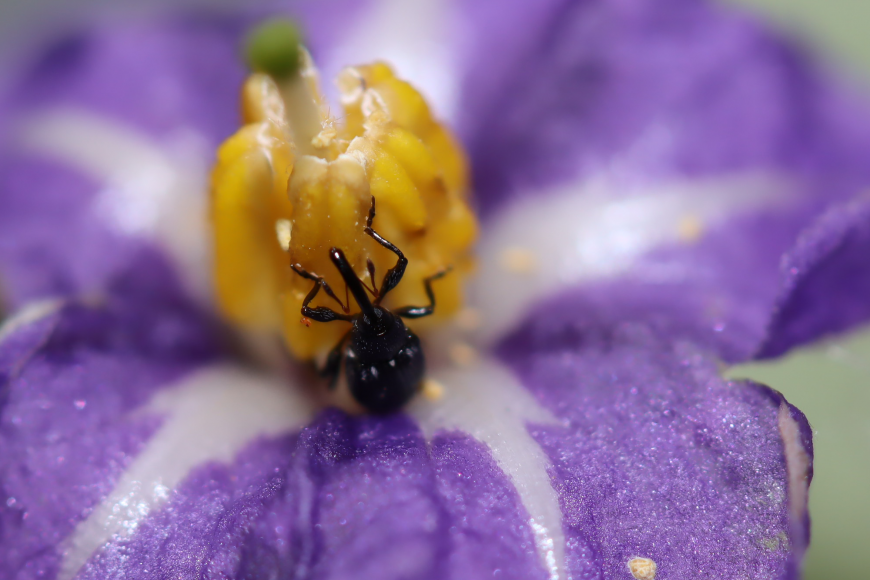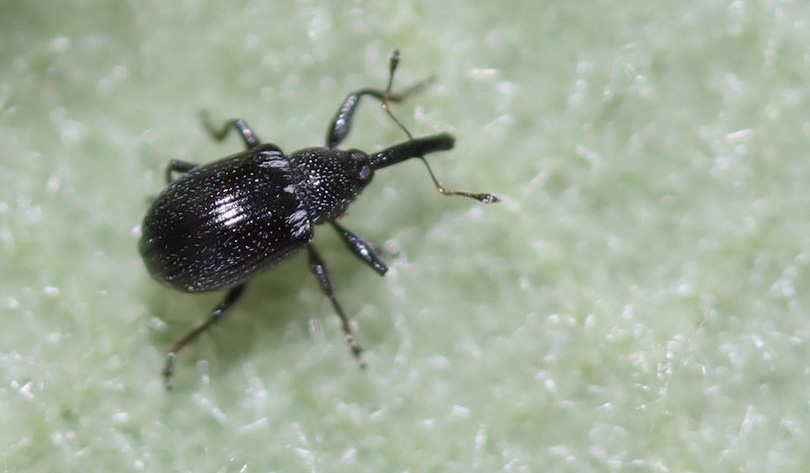Woolly Nightshade Still a Tough Target

Flower bud weevil adult
During this time Wits has undertaken host specificity testing with the weevil on commercially important crop species or varieties in the Solanum genus (e.g. eggplant/aubergine, Solanum melongena) and the Solanaceae family (e.g. chilli pepper / capsicum, Capsicum annum). The fundamental host range of the weevil has so far been assessed in no-choice and paired-choice adult feeding and oviposition trials, and in larval development trials. The adult weevils feed on the leaves of woolly nightshade, and the larvae feed and develop inside the flowerbuds.
Preliminary results have shown that the weevil is able to feed and develop on some varieties of eggplant, but no development occurred on other important Solanaceous crops, such as potato (Solanum tubersosum) and tomato (Solanum lycopersicum). The eggplant variety ‘Black Beauty’, which is available for domestic cultivation in New Zealand, was particularly susceptible to feeding and oviposition. However, the numbers of larvae on eggplant were low compared to woolly nightshade, and the reproductive risk, considering oviposition preference and larval survival of the weevil on eggplant, was also very low.

Flower bud weevil adult
“These findings are not entirely unexpected, since host specificity testing of another closely related flowerbud weevil (Anthonomus santacruzi) produced similar results in the laboratory,” explained Nic Venter (Wits University), who is leading this research in South Africa. “However, further testing of this weevil under multi-choice conditions, and a risk assessment, suggested that the risk to non-target Solanum species such as eggplant was low. This weevil was released as a biocontrol agent for woolly nightshade in South Africa in 2009, and non-target impacts have not been recorded in over a decade,” he added.
This weevil was also considered for release in New Zealand in the early 2010s, but the results from no-choice tests with our native poroporo species (Solanum aviculare and S. laciniatum) were a cause for concern. Complete development occurred on S. aviculare, which is significant for Māori as a food, medicinal and culturally important plant. This poroporo species also has a current conservation status of ‘Threatened – Nationally Vulnerable’ (www.nzpcn.or.nz/flora/species/solanum-aviculare-var-aviculare).
With this in mind, seeds of both poroporo species were sent to Wits in November last year for cultivating to undergo host specificity testing with the new flowerbud weevil. “Although the host testing results with eggplant are a little concerning, it will be crucial to have a full set of results of host testing the poroporo species, and the additional testing planned with eggplant, before we can assess the safety of this weevil for release in New Zealand,” said Angela Bownes, who leads this project. “Wits will soon start feeding trials with the adult weevils, and floral trials to assess oviposition and larval development will commence as soon as the plants start flowering,” she added. Wits also plans to do more testing with eggplant and other commercial and South African native species closely related to woolly nightshade. Other research conducted by Wits demonstrated that the new flowerbud weevil has a lower thermal tolerance compared to its congener released in South Africa, whose distribution is restricted to the subtropical belt along the east coast of the country. So in terms of climate, the new flowerbud weevil is a better match for New Zealand, as a lower thermal tolerance suggests a higher tolerance of cooler climates.
Although having a biocontrol agent that can reduce woolly nightshade’s prolific fruit production is highly desirable, the search for new agents won’t stop with the flowerbud weevil. Other promising candidates include two stem weevils. Little is known about these weevils, but now that international travel is back on the cards, we hope to investigate them further in the native range as soon as possible. Woolly nightshade is still proving itself to be a tough target, but we’re not done with this weed yet!
Key contact
